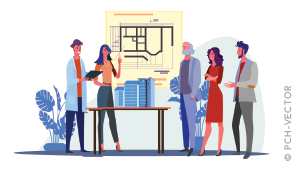
Fam Pract Manag. 2020;27(2):32
MAKE OFFICE REDESIGN A COLLABORATIVE PROJECT

When we set out to redesign our community health center, we made sure everyone on staff had input.
We were completely renovating the facility from the ground up, so we asked everyone to draw up a wish list of what they wanted to see when it was done. Then we took that information to the architects and asked them to try to make everyone's wishes reality.
The collaborative approach led to a facility that was not only larger and more brightly lit, but also more efficient. The new design streamlined the way patients move through our facility by reducing bottlenecks. It also created “work pods” where physicians and support staff can talk without patients overhearing them.
Getting everyone involved in the design process fostered a sense of ownership in the day-to-day work inside the facility and made us a tighter team.
DESIGNATE A VACCINE UPDATE EXPERT
A claims analysis by The Doctors Company, a physician-owned medical malpractice insurer, found several lawsuits related to vaccines.
In one case an infant received the Prevnar 7 vaccine but did not receive the Prevnar 13 shot during three subsequent well-child visits, because the physician had not updated the office's immunization protocols after the new shot became available. The infant later contracted serotype 6A pneumococcal meningitis, which is covered by Prevnar 13 but not Prevnar 7. The illness caused seizures, vision loss, hearing impairment, and hemiparesis on the child's left side.
Physicians should designate a staff member within their offices to monitor updates to federal vaccine schedules and make sure any changes to the schedules are promptly included in office protocols.
HANDLE DISABILITY EXAMS WITH EMPATHY AND PRACTICALITY
A serious neck injury about 15 years ago changed how I think about exams related to Social Security disability applications. I try not to jump to conclusions about the patient's condition now, and I record as much objective evidence as I can gather.
Since the injury I have days when I take no meds and walk fine. I have other days when I do too much, and then for the next 24 to 36 hours it feels like my arm is melting and a blow dryer is set on high in my axilla. A home traction unit and rest allow me to return to work most of the time in one or two days. I am lucky that I can manage that, but many people cannot find a job that allows that type of intermittent time off, even with the Family and Medical Leave Act.
So when I do disability exams, I try to stay neutral and stick to the findings. I write exactly what I see and hear. I ask the patient, “How many hours out of an eight-hour day can you do X?” If this adds up to a part-time office job, I ask if the patient has tried that.
I also have referred patients for a formal physical capacity evaluation, but it is expensive and many times not a covered benefit under their insurance unless you are using it to begin a rehabilitation program.
Some parts of the formal evaluation can be simulated in the office. For example, for patients who report that they cannot lift 10 pounds, or repeatedly say “I don't know,” I have been known to bring to the exam room a gallon jug of distilled water I use for the sterilizer and an unopened five-gallon water cooler jug. Then I ask the patient to try to lift each one.
A comprehensive exam can take up to an hour. The form has a date that you performed the exam and, after asking the patient how he or she is feeling, I often make a comment on the form that the exam was performed on a “good” or “average” day, depending on the patient's answer.
